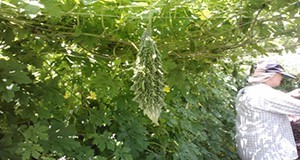Abstract
Bitter melon is a tropical and subtropical vegetable crop with long climbing vines which is widely cultivated in Asia, Africa, and the Caribbean. The unripe fruit is used as a vegetable with a pleasantly bitter taste. This 7-page fact sheet provides an overview of this plant as well as recommendations for individuals in Florida who are interested in growing it. Written by Guodong Liu, Qingren Wang, Yuncong Li, David Dinkins, Bonnie Wells, and Yuqi Cui, and published by the UF Department of Horticultural Sciences, December 2015.
HS1271/HS1271: Bitter Melon—an Asian Vegetable Expanding in Florida (ufl.edu)
References
AgriFarming. 2015. "Bitter gourd farming information guide." #1 Source for Farming in India. Accessed December 3, 2015. http://agrifarming.in/bitter-gourd-farming
Behera, T. K., S. Behera, L. K. Bharathi, K. J. John, P. W. Simon, and J. E. Staub. 2010. Bitter Gourd: Botany, Horticulture, Breeding. Horticultural Reviews (ed. J. Janick.) 37: 101-41. Accessed December 3, 2015. http://naldc.nal.usda.gov/download/42264/PDF https://doi.org/10.1002/9780470543672.ch2
Beloin, N., M. Gbeassor, K. Akpagana, J. Hudson, K. De Soussa, K. Koumaglo, and J. T. Arnason. 2005. "Ethnomedicinal uses of Momordica charantia (Cucurbitaceae) in Togo and relation to its phytochemistry and biological activity." Journal of Ethnopharmacology 96: 49-55. https://doi.org/10.1016/j.jep.2004.08.009
Chen, Q., L. L. Chan, and E. T. Li. 2003. "Bitter melon (Momordica charantia) reduces adiposity, lowers serum insulin and normalizes glucose tolerance in rats fed a high fat diet." The Journal of Nutrition 133: 1088-93. https://doi.org/10.1093/jn/133.4.1088
Freeman, J. H., E. J. McAvoy, P. J. Dittmar, M. Ozores-Hampton, M. Paret, Q. Wang, C. F. Miller, and S. E. Webb. 2015. Cucurbit production. HS725. Gainesville: University of Florida Institute of Food and Agricultural Sciences. Accessed December 3, 2015. http://edis.ifas.ufl.edu/cv123
Grover, J. K., and S. P. Yadav. 2004. "Pharmacological actions and potential uses of Momordica charantia: A review." Journal of Ethnopharmacology 93: 123-32. Accessed December 3, 2015. http://www.sciencedirect.com/science/article/pii/S037887410400159X https://doi.org/10.1016/j.jep.2004.03.035
Lim, T. K. 2013. Edible medicinal and non-medicinal plants. Dordrecht: Springer. 331-32. https://doi.org/10.1007/978-94-007-5628-1
Liu, G. D., E. H. Simonne, K. T. Morgan, G. J. Hochmuth, M. Ozores-Hampton, and S. Ageharas. 2015. Chapter 2. Fertilizer management for vegetable production in Florida. CV296. Gainesville: University of Florida Institute of Food and Agricultural Sciences. Accessed December 3, 2015. http://edis.ifas.ufl.edu/pdffiles/cv/cv29600.pdf
Lo, H. Y., T. Y. Ho, C. Lin, C. C. Li, and C. Y. Hsiang. 2013. "Momordica charantia and its novel polypeptide regulate glucose homeostasis in mice via binding to insulin receptor." Journal of Agricultural and Food Chemistry 61 : 2461-8. https://doi.org/10.1021/jf3042402
Ooi, C. P., Z. Yassin, and T. A. Hamid. 2012. "Momordica charantia for type 2 diabetes mellitus." The Cochrane Library 8: CD007845. https://doi.org/10.1002/14651858.CD007845.pub3
Palada, M. C., and L. C. Chang. 2003. "Suggested cultural practices for bitter gourd." International Cooperators' Guide. Asian Vegetable Research and Development Center (AVRDC) pub# 03-547. 1-5. Accessed December 3, 2015. http://203.64.245.61/web_crops/cucurbits/bittergourd.pdf
Paul, A., and S. S. Raychaudhuri. 2010. "Medicinal uses and molecular identification of two Momordica charantia varieties - A review." Electronic Journal of Biology 6: 43-51.
Stephens, J. M. 2012. Momordica-Momordica spp. HS627. Gainesville: University of Florida Institute of Food and Agricultural Sciences. http://edis.ifas.ufl.edu/mv094.
USDA-ARS. 2015. National Nutrient Database for Standard Reference Release 28, Full Report (All Nutrients) 11025, Balsam-pear (bitter gourd), pods, cooked, boiled, drained, without salt. http://ndb.nal.usda.gov/ndb/foods/show/2833?fg=&manu=&lfacet=&format=Full&count=&max=35&offset=&sort=&qlookup=11025
Wang, J., and H. K. Ryu. 2015. "The effects of Momordica charantia on obesity and lipid profiles of mice fed a high-fat diet." Accessed December 3, 2015. http://www.ncbi.nlm.nih.gov/pubmed/26425278
Zhang, S., M. Lamberts, and E. McAvoy. 2012. Diseases of bitter melon in south Florida. PP300. Gainesville: University of Florida Institute of Food and Agricultural Sciences. Accessed December 3, 2015. https://edis.ifas.ufl.edu/pp300

